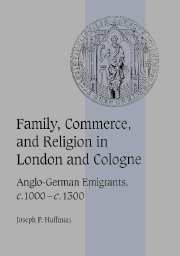Book contents
- Frontmatter
- Contents
- Preface
- List of abbreviations
- The wards of medieval London
- The parishes and districts of medieval Cologne
- Anglo-Cologne family genealogies
- Introduction
- Part I The historical background: Anglo-German commercial foundations and the city of Cologne
- Part II Anglo-Cologne family, property, and inheritance ties
- Part III Anglo-German religious and cultural life
- Chapter 8 Confraternities, expatriate monks, pious legends, and pilgrims
- Chapter 9 Clerics, canon law, crusaders, and culture
- Conclusion: A reappraisal of the Anglo-German nexus
- Appendix: The archbishops of Cologne
- Select Bibliography
- Index
- Cambridge Studies in Medieval Life and Thought Fourth series
Chapter 8 - Confraternities, expatriate monks, pious legends, and pilgrims
Published online by Cambridge University Press: 02 November 2009
- Frontmatter
- Contents
- Preface
- List of abbreviations
- The wards of medieval London
- The parishes and districts of medieval Cologne
- Anglo-Cologne family genealogies
- Introduction
- Part I The historical background: Anglo-German commercial foundations and the city of Cologne
- Part II Anglo-Cologne family, property, and inheritance ties
- Part III Anglo-German religious and cultural life
- Chapter 8 Confraternities, expatriate monks, pious legends, and pilgrims
- Chapter 9 Clerics, canon law, crusaders, and culture
- Conclusion: A reappraisal of the Anglo-German nexus
- Appendix: The archbishops of Cologne
- Select Bibliography
- Index
- Cambridge Studies in Medieval Life and Thought Fourth series
Summary
As in most cases, it was the monks who led the way in establishing such interregional ties. Our first surviving evidence comes from a single folio page of Harley MS. 1805 in the British Museum. This manuscript contains an Old Testament in Carolingian minuscule from the Tours school dated pre-820, and attached to it is a smaller parchment folio whose script dates from the early eleventh century and whose current function is to serve as the manuscript's front flyleaf. On this folio there appears a list of Cologne churches along with 371 German names listed in two columns. The names of prominent deacons and abbesses are inscribed among the many other members of these communities, no doubt in an effort either to establish or maintain a prayer confraternity with an English monastic house (or houses). The early date of this confraternity is striking, as it was probably established before the Norman Conquest.
We know nothing about the English community to whom the prayer list was sent, but a later similar document tells us much more. In 1936 the names of monks from the Cologne abbey of Siegburg were discovered at the archive of Christ Church, Canterbury by the archivist P. W. Blore.4 He identified a rectangular parchment leaf containing a twelve-line list of names of thirty-one deceased monks, for whom prayers were requested from the Benedictines at Christ Church, Canterbury.
- Type
- Chapter
- Information
- Family, Commerce, and Religion in London and CologneAnglo-German Emigrants, c.1000–c.1300, pp. 199 - 216Publisher: Cambridge University PressPrint publication year: 1998



